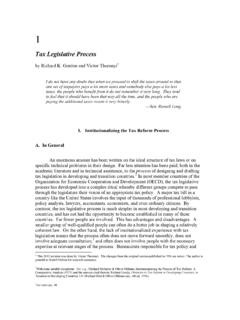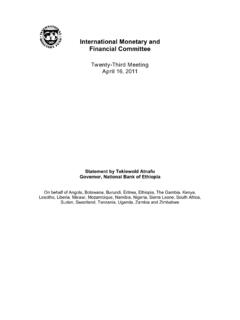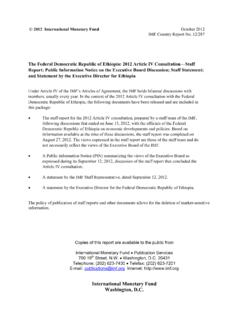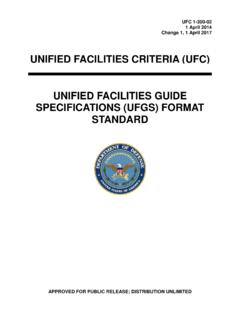Transcription of The Special Data Dissemination Standard Plus - IMF
1 INTERNATIONAL MONETARY FUND. The Special data Dissemination Standard plus Guide for Adherents and Users December 2015. 5293924v7. ii Contents Preface iv Acknowledgments v abbreviations vi 1. The Special data Dissemination Standard plus : Origin and Key Features .. 1. 2. Real Sector: data Coverage, Periodicity, and Timeliness .. 11. 3. Fiscal Sector: data Coverage, Periodicity, and Timeliness .. 14. 4. Financial Sector: data Coverage, Periodicity, and Timeliness .. 21. 5. External Sector: data Coverage, Periodicity, and Timeliness .. 28. iii Boxes Tables iv Preface SDDS plus Guide Acknowledgments 5293924v7. ii abbreviations iii Chapter 1. The Special data Dissemination Standard plus : Origin and Key Features Origin and Purpose.
2 5293924v7. 2. Box Establishment of the SDDS plus and the SDDS plus Guide The Special data Dissemination Standard plus (SDDS plus ) was approved by the IMF's Executive Board during the eighth review of the IMF's data standards Initiatives in February 2012. Based on this review, a legal text describing the requirements for SDDS plus was prepared and approved by the Board in October 2012, and subsequently amended in March 2014 to reflect: (i) the extension of the timeliness for three data categories (sectoral accounts, other financial corporations survey, and debt securities) from one-quarter to 4 months; and (ii) updated methodologies under the Basel Accords for the financial soundness indicators data category.
3 (The revised legal text is available on the Internet at ). This SDDS plus Guide was first prepared by IMF staff, based on the understandings detailed in the SDDS plus legal text of October 2012, and is revised to reflect amendments approved by the Executive Board and elaboration of a few aspects of the initiative to clarify requirements. Any future changes or enhancements to the SDDS plus initiative, including data coverage, periodicity, and timeliness, could only take place after discussion by the IMF's Executive Board and the approval of a revised legal text reflecting these changes. The legal text includes references to the recommended methodologies based on the latest editions of manuals and guides for the nine SDDS plus data categories.
4 The reference to a successor methodology is included to further encourage adherents to adopt the successor methodology as it becomes available. It also allows countries that decide to adopt these successor methodologies to report data , with comparable detail, using the new methodology. The IMF's Executive Board reviews the IMF's data standards Initiatives periodically. 1. The SDDS requirements are detailed in the Special data Dissemination Standard : Guide for Subscribers and Users (SDDS Guide), available at , which should be referred to when using this guide. 3. 4. Key Aspects of Dissemination .. 2. For information on the prescribed SDDS data categories and the coverage, periodicity, and timeliness requirements related to these data categories, see the SDDS Guide.
5 5. Box The Dimensions and Monitorable Elements of the SDDS plus data Coverage, Periodicity, and Timeliness: Comprehensive economic and financial data disseminated on a timely basis are essential to the transparency of macroeconomic performance and policy analysis. Countries adhering to the Special data Dissemination Standard plus (SDDS plus ) are obliged to disseminate the prescribed categories of data with the specified coverage, periodicity, and timeliness. Access by the Public: Dissemination of official statistics is an essential feature of statistics as a public good. The SDDS plus calls for providing the public, including market participants, ready and equal access to the data .
6 Countries adhering to the SDDS plus are obliged to disseminate advance release calendars (ARCs) for the data except for coordinated portfolio investment survey (CPIS), coordinated direct investment survey (CDIS), and currency composition of official foreign exchange reserves (COFER) data ; and release the data , except CPIS, CDIS, and COFER data , to all interested parties simultaneously. There are no ARC dates associated with CPIS, CDIS, and COFER data . The SDDS. plus only calls for reporting to the International Monetary Fund (IMF) within the specified timeliness for these three categories, along with redissemination on the National Summary data Page (NSDP) for only CPIS and CDIS (not COFER).
7 The time of Dissemination could be at the same time as the reporting to the IMF or immediately after the CPIS. and CDIS data are disseminated by the IMF on the CPIS and CDIS websites maintained by the IMF. If adherents decide to disseminate these data immediately after the data are disseminated by the IMF, they can either redisseminate the data on the NSDP or provide a hyperlink on the NSDP to the CPIS and CDIS websites maintained by the IMF. Integrity: To fulfill the purpose of providing the public with information, official statistics must have the confidence of their users. In turn, confidence in the statistics ultimately becomes a matter of confidence in the objectivity and professionalism of the agency producing the statistics.
8 Transparency of practices and procedures is a key factor in creating this confidence. Countries adhering to the SDDS plus are obliged to (1) disseminate the terms and conditions under which official statistics are produced, including those relating to the confidentiality of individually identifiable information; (2) identify internal government access to data before release to the public; (3) identify ministerial commentary on the occasion of statistical releases; and (4) provide information about revisions and advance notice of major changes in methodology. Quality: A set of standards that deals with the coverage, periodicity, and timeliness of data must also address the quality of statistics.
9 Although quality is difficult to judge, monitorable proxies, designed to focus on information the user needs to judge quality, can be useful. Countries adhering to the SDDS plus are obliged to (1) disseminate documentation on methodology and sources used in preparing statistics, including the identification of methodological deviations from internationally accepted statistical methodologies; (2) encouraging data modules of the Reports on the Observance of standards and Codes ( data ROSCs) or other quality assessments every 7 10 years; and (3). disseminate component detail, reconciliations with related data , and statistical frameworks that support statistical cross- checks and provide assurance of reasonableness.
10 6.. 3. Establishing a revision policy and publishing revisions in a transparent manner, as well as engaging in open communication with data users, are recommended. The objective of revision policies is to disseminate to the public data of better quality as it becomes available. For instance, quarterly data can be revised due to the increase in the number of reporting entities or as a result of quality checks performed after the data have been disseminated. A typical example of the latter is the benchmarking of quarterly data to annual data when the annual data become available. Compilers are encouraged to develop integrated revision policies that explain clearly how more frequent data can be revised as a result of the publication of less frequent data .















